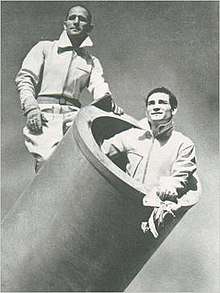Hugo Zacchini
Hugo Zacchini (20 October 1898 – 20 October 1975), one of the Zacchini Brothers, was the first human cannonball to use a compressed-air cannon. His father Ildebrando Zacchini invented the compressed-air cannon used to propel humans in circus acts. He was known for being a daredevil and a painter.
Hugo Timonte Zacchini | |
|---|---|
 | |
| Born | October 20, 1898 Santa Ana, Peru, South America |
| Died | October 20, 1975 (aged 77) |
| Education | University of Florida; Attended Rome Arts Academy where at age of 12 he graduated. Graduated Jamestown Academy in New York, where he received a Master's in Art. |
| Occupation | Daredevil and artist, sculptor, taught art in Chaffey College, interpreter to as many as 11 languages. |
| Spouse(s) | Elsa Gertrude Walker Zacchini |
| Children | Hugo Anthony Zacchini, Patchay "Pat" Zacchini |
Biography
He was born on October 20, 1898 in Santa Ana, Peru to Maddelen and Ildebrando Zacchini. He held two engineering degrees from the University of Florida. The Zacchini family was originally from Italy, and has performed in various circuses for several generations. Ildebrando Zacchini's circus was touring Peru at the time of Hugo's birth. Hugo grew up in his father's circus, where he learned to perform juggling, trapeze and other circus acts.
The famous Zacchini cannon was designed in 1922 by Hugo's father Ildebrando, with the help of Hugo and his brothers Edmondo and Bruno. The cannon act was first performed publicly on the Zacchini Circus while performing in Egypt.
In 1928 while Hugo was performing his cannon act in Copenhagen, Denmark, he was discovered by circus owner John Ringling, who offered Zacchini a contract with the Ringling Bros. and Barnum & Bailey Circus.
Zacchini was involved with a lawsuit that made it before the U.S. Supreme Court, Zacchini v. Scripps-Howard Broadcasting Co., a case which he ultimately won in 1977. Zacchini sued Scripps-Howard, the owner of an Ohio television station, when it filmed, and then broadcast Zacchini's entire act of being shot out of a cannon at the Geauga County Fair in Burton, Ohio.[1] The United States Supreme Court sided with Zacchini, ruling 5 to 4 that his personality rights overrode the First Amendment rights in this case where the entire act was shown on television in violation of his common law copyright.[2][3]
Although best known as the "human cannonball", Zacchini was also an accomplished artist. He studied art at the Rome Arts Academy in Italy and received a Master's in Art degree from Jamestown Academy in Jamestown, New York.
Hugo Zacchini died on October 20, 1975, his 77th birthday, in San Bernardino, California.[4]
References
- White, Byron (28 June 1977). "HUGO ZACCHINI, PETITIONER, V. SCRIPPS-HOWARD BROADCASTING COMPANY". Legal Information Institute. Cornell Law School. Retrieved 27 April 2014.
- "First Amendment Limitations on Civil Law Liability". University of Missouri, Kansas City. Retrieved 2008-08-04.
- "Image Rights vs. Free Speech in Video Game Suit". New York Times. November 15, 2010. Retrieved 2012-11-03.
The court has taken up the right-of-publicity issue only once, in 1977, when it ruled in favor of Hugo Zacchini, a circus performer who originated the human cannonball act and who sued the owner of a television station that broadcast his entire act without his consent.
- McQuiston, John T. (October 21, 1975). "Hugo Zacchini, 77, Dies; First Human Cannonball". New York Times. Retrieved 2008-08-04.
Hugo Zacchini, a circus performer who originated the human cannonball act in which he was catapulted from a cannon 200 feet into a net, died yesterday of a stroke in San Bernardino, Calif. He was 77 years old.